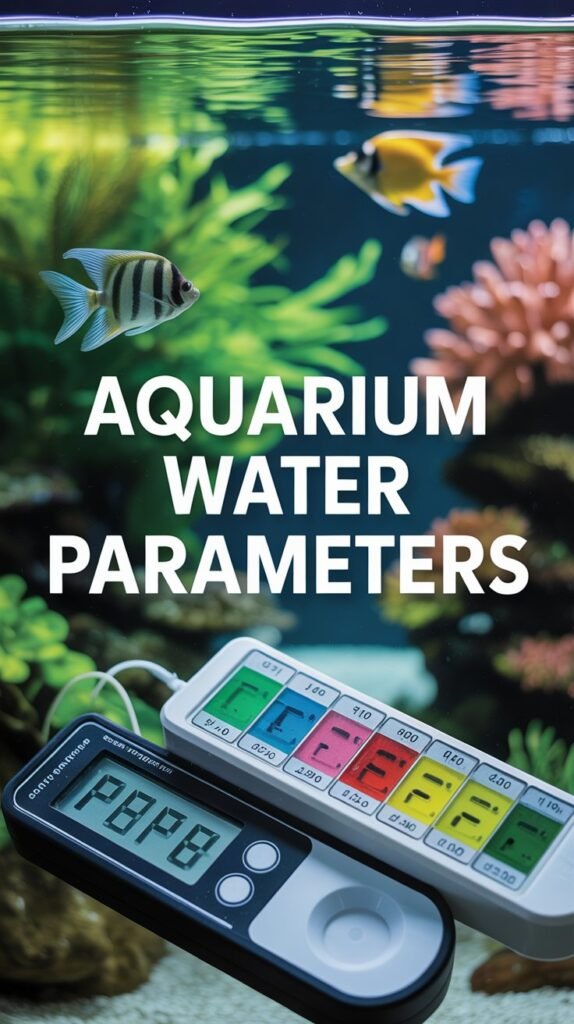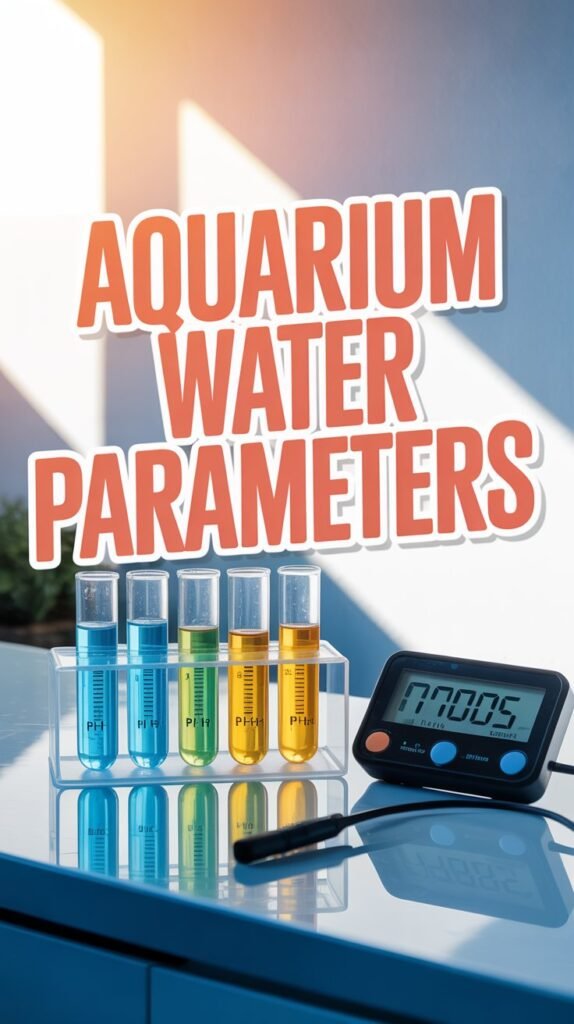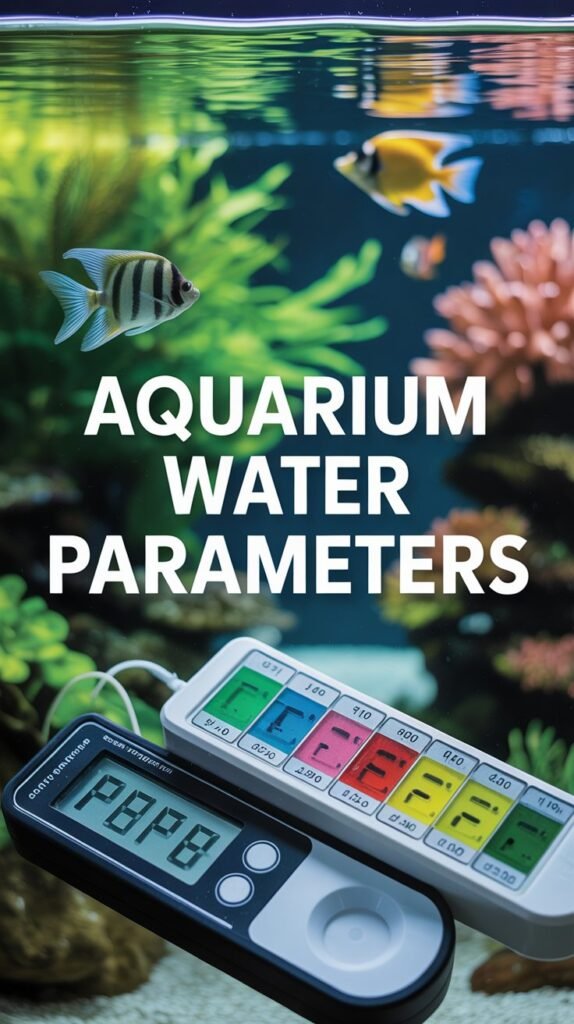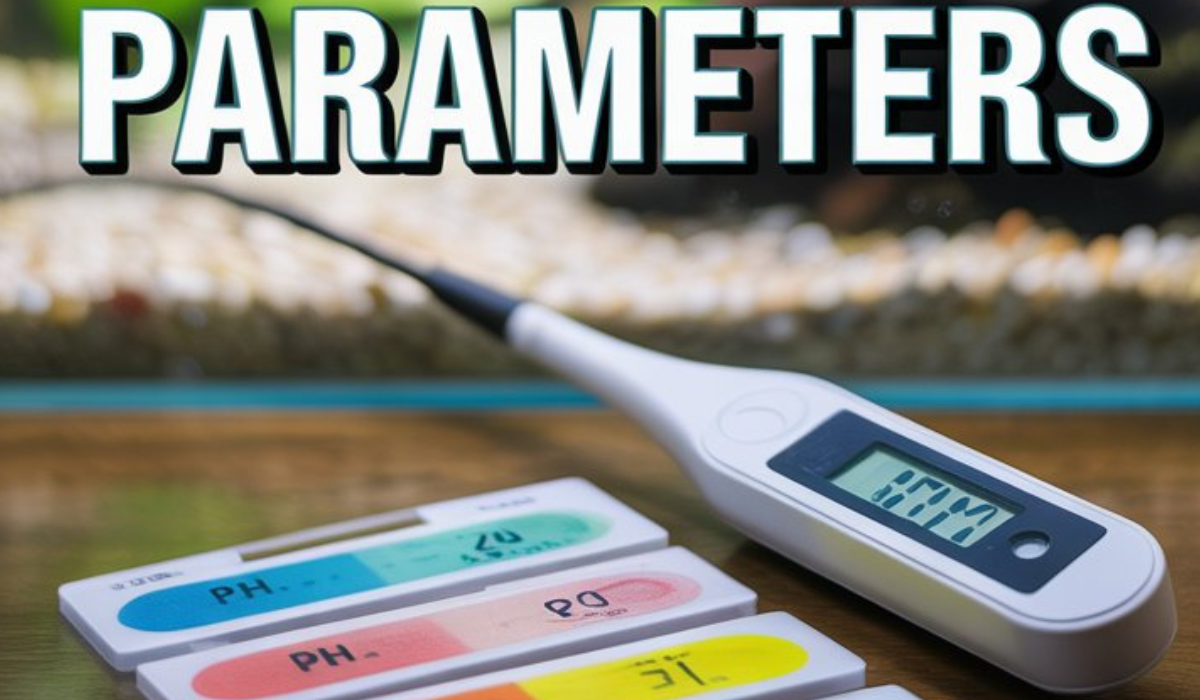Keeping a thriving aquarium is more than just adding water and fish—it’s about maintaining a balanced ecosystem. The foundation of that ecosystem lies in your aquarium water parameters. Whether you’re a beginner aquarist or an experienced hobbyist, understanding and managing these parameters is essential for the health of your aquatic life.
In this comprehensive guide, we’ll explore the key aquarium water parameters, how to test and adjust them, and why maintaining balance is crucial for fish, plants, and beneficial bacteria.
What Are Aquarium Water Parameters?
Aquarium water parameters refer to the chemical and physical properties of your aquarium water that affect the wellbeing of fish, plants, and microorganisms. These include temperature, pH, ammonia, nitrite, nitrate, hardness, alkalinity, and more.
Each species of fish and plant thrives within specific ranges of these parameters. Deviations can lead to stress, disease, or even death. Therefore, regularly testing and maintaining optimal water conditions ensures a stable environment.
Why Aquarium Water Parameters Matter

Water might look clean, but appearances can be deceiving. Toxic compounds like ammonia and nitrite are invisible yet deadly to aquatic life. Even small fluctuations in pH or temperature can cause stress or disrupt biological processes.
Here’s why monitoring parameters matters:
- Fish health: Stable water conditions reduce stress and boost immunity.
- Plant growth: Aquatic plants require balanced nutrients and CO₂.
- Beneficial bacteria: The nitrogen cycle depends on stable chemistry.
- Algae control: Balanced nutrients prevent algae outbreaks.
- Tank stability: Regular checks prevent sudden crashes or fish loss.
Simply put, good water quality equals a healthy aquarium.
Essential Aquarium Water Parameters
Let’s break down each key parameter and understand its role, ideal range, and how to manage it.
1. Temperature
Importance: Temperature affects metabolism, breeding, and overall activity of aquatic life. Sudden changes can shock fish and lead to disease.
Ideal Ranges:
- Freshwater tropical fish: 24°C – 28°C (75°F – 82°F)
- Coldwater fish (like goldfish): 18°C – 22°C (65°F – 72°F)
- Planted aquariums: 24°C – 27°C (75°F – 80°F)
How to Maintain:
- Use an aquarium heater with a thermostat.
- Monitor with a digital thermometer.
- Avoid placing the tank near windows or heat sources.
Tip: Stability is more important than perfection. A consistent temperature prevents stress.
2. pH Level
Importance: pH measures how acidic or basic the water is. Most fish species prefer neutral to slightly acidic or basic water.
Ideal Ranges:
- Community tanks: 6.8 – 7.6
- Amazonian species (e.g., tetras, discus): 6.0 – 7.0
- African cichlids: 7.8 – 8.6
How to Adjust:
- To raise pH: Add crushed coral, limestone, or use pH buffers.
- To lower pH: Add driftwood, Indian almond leaves, or peat moss.
Testing: Use aquarium pH test kits or digital pH meters weekly.
3. Ammonia (NH₃)
Importance: Ammonia is produced from fish waste, uneaten food, and decaying matter. Even low levels can burn fish gills and cause death.
Safe Range:
- 0 ppm (parts per million) is ideal. Any detectable ammonia is toxic.
How to Control Ammonia:
- Perform regular water changes (20–30%) weekly.
- Avoid overfeeding.
- Ensure your tank is cycled before adding fish.
- Use biological filtration (e.g., sponge filters, bio media).
Emergency Fix: Use ammonia detoxifiers if levels rise suddenly.
4. Nitrite (NO₂⁻)
Importance: Nitrite forms when bacteria convert ammonia during the nitrogen cycle. It’s less toxic than ammonia but still harmful.
Safe Range:
- 0 ppm (any detectable nitrite is dangerous).
How to Control Nitrite:
- Maintain a mature biological filter.
- Avoid cleaning all filter media at once.
- Use Prime or Amquel Plus to neutralize nitrite spikes.
Tip: If nitrite appears after adding new fish, your biofilter may be adjusting.
5. Nitrate (NO₃⁻)
Importance: Nitrate is the final byproduct of the nitrogen cycle. It’s less harmful but can cause long-term stress and algae blooms.
Safe Range:
- Freshwater fish tanks: Below 40 ppm
- Planted tanks: 10–20 ppm (plants use nitrate as fertilizer)
How to Control Nitrate:
- Weekly partial water changes.
- Add live plants to absorb excess nitrate.
- Avoid overstocking.
- Clean substrate regularly.
Note: High nitrate levels can lead to poor fish color, lethargy, and slow growth.
6. General Hardness (GH)

Importance: GH measures the concentration of dissolved minerals like calcium and magnesium. It affects fish osmoregulation and plant health.
Ideal Ranges:
- Soft water species (tetras, bettas): 4–8 dGH
- Hard water species (livebearers, cichlids): 10–20 dGH
How to Adjust GH:
- To increase GH: Add crushed coral or commercial mineral salts.
- To decrease GH: Use reverse osmosis (RO) water or demineralized water.
7. Carbonate Hardness (KH)
Importance: KH (or alkalinity) stabilizes pH by buffering against sudden changes. Low KH can cause pH swings, stressing fish.
Ideal Ranges:
- Community tanks: 4–8 dKH
- African cichlids: 10–18 dKH
How to Maintain KH:
- Add baking soda or crushed coral to increase KH.
- Avoid overusing acids or CO₂ without monitoring KH levels.
Tip: Regularly test KH if you inject CO₂ in planted aquariums.
8. Dissolved Oxygen (O₂)
Importance: Fish and beneficial bacteria need oxygen to survive. Poor aeration leads to suffocation, especially in warm water.
How to Maintain Oxygen Levels:
- Use air stones or sponge filters.
- Ensure good surface agitation.
- Avoid overstocking and overfeeding.
- Keep temperature moderate—warm water holds less oxygen.
9. Phosphate (PO₄)
Importance: Phosphate is a nutrient for plants but can cause algae blooms when levels are too high.
Ideal Range:
- Planted aquariums: 0.5–2.0 ppm
- Fish-only tanks: <0.5 ppm
How to Control:
- Limit overfeeding.
- Use phosphate-absorbing media.
- Perform regular water changes.
10. Salinity (for Brackish and Marine Tanks)
Importance: Salinity measures the salt content of the water. It’s crucial for marine and brackish aquariums but irrelevant for freshwater tanks.
Ideal Range:
- Marine tanks: 1.020 – 1.026 specific gravity
- Brackish tanks: 1.005 – 1.015
Tools: Use a refractometer or hydrometer to measure accurately.
Understanding the Nitrogen Cycle

Before managing parameters, it’s essential to understand the aquarium nitrogen cycle—the biological process that keeps your tank safe for fish.
- Ammonia (toxic) is produced from waste.
- Nitrosomonas bacteria convert ammonia to nitrite.
- Nitrobacter bacteria convert nitrite to nitrate.
- Nitrate is removed through water changes or absorbed by plants.
This cycle typically takes 4–6 weeks to establish in a new aquarium. Never add all your fish before the cycle completes.
Tools and Kits for Monitoring Water Parameters
To maintain ideal aquarium water conditions, you need accurate testing tools. Here are some recommended options:
- Aquarium Test Strips: Quick and easy but less precise.
- Liquid Test Kits: Highly accurate for measuring pH, ammonia, nitrite, and nitrate.
- Digital Meters: Measure temperature, TDS, and pH instantly.
- Refractometers: For measuring salinity in marine/brackish tanks.
Tip: Test your water at least once a week—and always after major water changes or adding new fish.
How to Maintain Stable Aquarium Water Parameters
Consistency is key. Here are best practices to maintain balanced water parameters in your aquarium:
1. Regular Water Changes
Replace 20–30% of water weekly to remove waste, excess nutrients, and restore minerals.
2. Use Quality Water Source
Avoid untreated tap water. Use a water conditioner to neutralize chlorine and chloramine.
3. Proper Filtration
A good filter provides mechanical, chemical, and biological filtration, ensuring water clarity and stability.
4. Avoid Overfeeding
Feed only what fish can eat in 2–3 minutes. Excess food decomposes, raising ammonia and nitrate.
5. Monitor Stocking Levels
Overcrowded tanks produce excess waste and deplete oxygen quickly.
6. Clean Substrate and Decorations
Vacuum gravel regularly to remove detritus and uneaten food.
7. Maintain Live Plants
Plants absorb CO₂, nitrates, and phosphates, promoting a healthier ecosystem.
8. Quarantine New Fish
Prevent introducing parasites or bacteria that can upset water balance.
9. Regular Testing Routine
Track trends rather than one-time readings to spot problems early.
Common Water Parameter Problems and Fixes
| Problem | Possible Cause | Solution |
|---|---|---|
| High Ammonia | Overfeeding, uncycled tank | Water change, stop feeding, add bacteria starter |
| High Nitrite | Filter not matured | Add nitrifying bacteria, water change |
| High Nitrate | Overfeeding, rare water changes | Add plants, increase water change frequency |
| Low pH | Driftwood, soft water | Add crushed coral or buffer |
| High pH | Hard tap water, rocks | Add peat moss or almond leaves |
| Temperature Fluctuation | Unstable room temp | Use thermostat heater |
| Low Oxygen | Poor circulation | Add air stone, surface agitation |
The Role of Aquarium Plants in Water Balance
Live plants are nature’s filtration system. They:
- Absorb ammonia, nitrite, and nitrate
- Produce oxygen during photosynthesis
- Compete with algae for nutrients
- Stabilize pH by consuming CO₂
Popular beginner-friendly plants include Java Fern, Anubias, Amazon Sword, and Hornwort.
Using RO (Reverse Osmosis) Water for Precision Control
Reverse osmosis water has nearly zero dissolved minerals, making it perfect for customizing water parameters.
Pros:
- Ideal for sensitive species.
- Prevents mineral buildup.
- Consistent baseline for mixing.
Cons:
- Requires remineralization.
- Costly setup (RO unit).
Best For: Discus, shrimp, or planted aquariums where precise control matters.
Monitoring and Logging Your Water Parameters
Keeping a water parameter log helps you identify trends and prevent sudden crashes.
Example Log Sheet:
| Date | Temperature | pH | Ammonia | Nitrite | Nitrate | GH | KH |
|---|---|---|---|---|---|---|---|
| Oct 1 | 26°C | 7.2 | 0 | 0 | 20 | 8 | 6 |
| Oct 8 | 26°C | 7.1 | 0 | 0 | 15 | 8 | 6 |
Reviewing this log allows you to spot issues before they become critical.
Conclusion
Understanding and managing aquarium water parameters is the key to creating a stable, healthy, and beautiful aquatic environment. Every successful aquarist knows that clear water isn’t always clean water—true balance lies in chemistry, consistency, and care.
By regularly testing, maintaining, and adjusting these parameters, you ensure your fish thrive, your plants flourish, and your aquarium remains a vibrant underwater world.
FAQs About Aquarium Water Parameters
Q1. How often should I test my aquarium water?
You should test your aquarium water once a week and whenever you notice unusual fish behavior or cloudy water.
Q2. Can fish adapt to different water parameters?
Yes, many fish can adapt to a range of parameters, but sudden changes cause stress. Always acclimate new fish slowly.
Q3. What happens if pH levels fluctuate too much?
Rapid pH swings can cause pH shock, leading to stress, illness, or death. Maintain a stable KH to prevent this.
Q4. Do aquarium plants affect water parameters?
Absolutely. Plants help absorb nitrates and CO₂, stabilize pH, and improve oxygen levels.
Q5. How can I lower nitrate levels quickly?
Perform partial water changes, reduce feeding, and add fast-growing plants like Hornwort or Water Sprite.
Q6. What’s the easiest way to cycle a new aquarium?
Use a fishless cycle by adding bottled ammonia or beneficial bacteria and testing ammonia/nitrite until both reach zero.
Q7. Why does my aquarium smell bad even with clean water?
This usually indicates decaying organic matter or poor filtration. Clean the substrate, remove uneaten food, and check filter media.
Q8. Should I use tap water for my aquarium?
Yes, but always use a water conditioner to remove chlorine and chloramine before adding it to the tank.
Q9. What’s the difference between GH and KH?
GH measures mineral hardness (calcium, magnesium), while KH measures carbonate buffering capacity that stabilizes pH.
Q10. Can aquarium salt help stabilize parameters?
Aquarium salt can aid fish health but doesn’t balance pH, KH, or GH. Use it only for species that tolerate salt.

